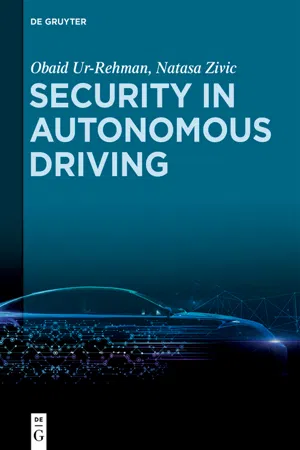
This is a test
- 221 pages
- English
- ePUB (mobile friendly)
- Available on iOS & Android
eBook - ePub
Security in Autonomous Driving
Book details
Book preview
Table of contents
Citations
About This Book
Autonomous driving is an emerging field. Vehicles are equipped with different systems such as radar, lidar, GPS etc. that enable the vehicle to make decisions and navigate without user's input, but there are still concerns regarding safety and security. This book analyses the security needs and solutions which are beneficial to autonomous driving.
Frequently asked questions
At the moment all of our mobile-responsive ePub books are available to download via the app. Most of our PDFs are also available to download and we're working on making the final remaining ones downloadable now. Learn more here.
Both plans give you full access to the library and all of Perlego’s features. The only differences are the price and subscription period: With the annual plan you’ll save around 30% compared to 12 months on the monthly plan.
We are an online textbook subscription service, where you can get access to an entire online library for less than the price of a single book per month. With over 1 million books across 1000+ topics, we’ve got you covered! Learn more here.
Look out for the read-aloud symbol on your next book to see if you can listen to it. The read-aloud tool reads text aloud for you, highlighting the text as it is being read. You can pause it, speed it up and slow it down. Learn more here.
Yes, you can access Security in Autonomous Driving by Obaid Ur-Rehman, Natasa Zivic in PDF and/or ePUB format, as well as other popular books in Ciencia de la computación & Interacción persona-computadora. We have over one million books available in our catalogue for you to explore.
Information
1 Introduction to Cryptography
1.1 Cryptography
1.1.1 Branches of Cryptology
1.1.1.1 Introduction
Cryptography is essential to providing security. In this chapter, the basic cryptographic concepts and terminologies are introduced. These concepts and terminologies will be used in different contexts in the following chapters.
1.1.1.2 Cryptology
Although cryptography is the main point of discussion in this chapter, there is a more generic umbrella term, called cryptology, which can be further split into cryptography and cryptanalysis.
1.1.1.3 Cryptography
Cryptography is the study and practice of methods for secure communication between two or more parties in the presence of adversaries. The goal is to conceal the meaning of messages exchanged among the communication partners. Cryptography can be further split into subfields such as symmetric encryption, asymmetric encryption and security protocols.
Cryptography provides among others
- Data confidentiality through encryption and decryption
- Data integrity
- Authentication of the communication partners
- Authentication of data source
Cryptography is ubiquitous in the modern digital. Some of the applications of cryptography include
- Online banking
- E-mail exchange
- Internet communications
- Mobile communications
- Virtual private networks
Fig. 1.1 shows cryptology and some of its most important subfields.

Fig. 1.1: Branches of cryptology.
1.1.1.4 Encryption
Encryption transforms the original data, called plaintext, by applying mathematical transformations into another form, called ciphertext, which cannot be understood by a third party or an adversary. The transformation is reversible, which means it is always possible to get back the corresponding plaintext from a given ciphertext. Encryption algorithm uses side information, called a cryptographic key, in order to perform the transformation. The key is shared with the recipient through a secure channel. It is not intended to be disclosed to third parties and should be known only to the intended recipients of the message.
A simplified view of the encryption and decryption process with the help of a shared key K is shown in Fig. 1.2. The transmission can occur in time or space. When the transmission occurs in time, it means that the encrypted data is stored, for example, in a database, and retrieved later when it is decrypted. When the transmission occurs in space, it means that the encrypted data is sent to the receiver over an insecure communication channel. An insecure communication channel is the one which is shared by many communication partners including adversaries.

Fig. 1.2: Encryption and decryption.
1.1.1.5 Decryption
Decryption is the reverse process of encryption and transforms the ciphertext back to the corresponding plaintext by applying the mathematical transformations in reverse order. In order for decryption to be successful, the same key is needed which was used earlier for encryption of the data. Therefore, it is important to share this key with the desired communication partner and not to disclose it to unintended recipients.
1.1.1.6 Cryptographic Key
A cryptographic key is needed for encryption as well as decryption. The key is exchanged between the communication partners prior to the start of encrypted communication, that is, encryption/decryption. The key should be kept secret and never be disclosed. If the key is disclosed, the previous and future communication encrypted with the same key is compromised.
1.1.1.7 Cryptographic Protocol
A cryptographic protocol performs a security-related function by applying cryptographic functions, that is, it is the application of cryptographic algorithm for a specifi...
Table of contents
- Title Page
- Copyright
- Contents
- 1 Introduction to Cryptography
- 2 Threat Analysis and Risk Assessment
- 3 Machine Learning
- 4 Machine Learning for Anomaly Detection
- 5 Distributed Ledger Technologies
- 6 Self-Correcting and Authentication Algorithm for Automotive Applications
- Index